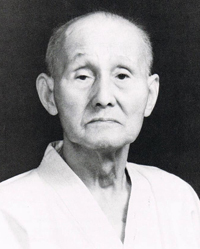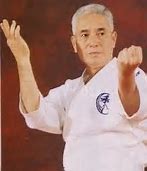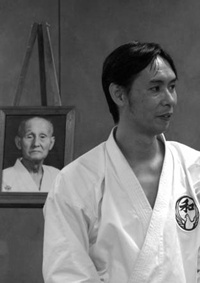History of Wado-Ryu Karate
It is extremely important to understand that the history of our style and the life of our founder are intertwined, as his lifelong martial arts journey and accumulation of knowledge is what inspired his beloved system. Therefore we can not tell one story without telling the other. The founder of Wadō-ryū, Hironori Ōtsuka, was born on 1 June 1892 in Shimodate, Ibaraki Prefecture, Japan. In 1898, Ōtsuka began practicing koryū jujutsu under Chojiro Ebashi. From 1905–1921, he studied Shindō Yōshin-ryū jujutsu under Tatsusaburo Nakayama. Ōtsuka’s extensive study of jujutsu would greatly influence his later perception of “Shotokan”, in those days simply called Karate.
In 1922, Ōtsuka met the legendary Gichin Funakoshi (who is known as “The Father of Modern Karate”, and the founder of the style Shotokan) at a sports festival in Tokyo. Funakoshi had been invited from Okinawa by the Japanese Ministry of Education to give a demonstration of what at the time was known as “China Hand (唐手)”. It would later be renamed “Empty Hand (空手)” by Funakoshi, mostly for political reasons during Japan’s impending war with China. The words when spoken, are both pronounced “Karate”.
Ōtsuka was very impressed with this Okinawan style of fighting, and met Funakoshi after the event to discuss martial arts for hours. Soon after he began to train in “Karate”. In 1924, Ōtsuka became one of the first students promoted to black belt in karate by Funakoshi. Ōtsuka rose to be one of Funakoshi’s head instructors, and trained closely under him for almost a decade.
To broaden his knowledge of Karate, Ōtsuka also studied with other prominent masters such as Kenwa Mabuni of Shitō-ryū and Chōki Motobu, the notorious street fighter from Okinawa. It is believed that from these two men that Master Ōtsuka learned and began to use “Kumite”, or sparring, with other students at the Tokyo University Karate Club. This is something that Funakoshi was greatly opposed to, as he saw it as barbaric to use Karate on someone else outside of a self defense situation. Ōtsuka however believed that without testing your techniques and ability, you would have no true way of being effective. This disagreement, coupled with many other conflicting ideas led to the two men’s split in the mid 1930’s.
Teacherless, and highly motivated Ōtsuka set out to develop his own way, combining all that he had learned from his teachers and approximately 40 years of experience. In 1938 , he registered his style with the Dai Nippon Butoku Kai under the name of “Shinshu Wadoryu Karate-Jujutsu.” Soon after, however, this was shortened to “Wadō-ryū” (和道流). In 1938, the Dai Nippon Butoku Kai awarded Ōtsuka the rank of Renshi-Go, followed in 1942 by the rank of Kyoshi-Go. In 1944, Ōtsuka was appointed Japan’s Chief Karate Instructor. It was during this time that Tatsuo Suzuki became a very promising student under Ōtsuka, becoming the highest ranked Wadoka within only a decade of training. Suzuki Sensei would go on to found the organization of Wado International Karatedo Federation.
Around 1950, Jiro Ōtsuka (the founder’s second son) began training in Wadō-ryū while in his adolescent years. In 1952, the Wadō-ryū headquarters (honbu) was established at the Meiji University dojo in Tokyo. In 1955, Ōtsuka published “Karatejutsu no Kenkyu,” a book expounding his style of karate. In 1963, he dispatched Suzuki, along with Toru Arakawa and Hajimu Takashima, to spread Wadō-ryū around the world.
In 1964, the Japan Karate Federation (JKF) was established as a general organization for all karate styles. Wadō-ryū joined this organization as a major group. In 1966, Ōtsuka was awarded the Order of the Rising Sun, Fifth Class by Emperor Hirohito for his dedication to the introduction and teaching of karate. On 5 June 1967, the Wadō-ryū organization changed its name to “Wadōkai.”
In 1972, the President of Kokusai Budō Renmei, a member of the Japanese royal family, awarded Ōtsuka the title of Meijin.
In 1980, as the result of a conflict between Ōtsuka and the Wadōkai organization, he stepped down as head of the organization. Eiichi Eriguchi took over as head of Wadōkai . On 1 April 1981, Ōtsuka founded the “Wadōryū Karatedō Renmei” (Renmei means “group” or “federation.”); however he stepped down due to failing health after only a few months and retired as head of the Renmei. His son, Jiro Ōtsuka, took his place. On 29 January 1982, Hironori Ōtsuka passed away at the age of 89, and in 1983, Jiro Ōtsuka succeeded him as grandmaster of Wadō-ryū. The younger Ōtsuka changed his name to “Hironori Otsuka II” in honor of his late father. After years of conflict, Suzuki left the Renmei and founded his organization in 1990. On 26 June 2015, Master Otsuka II followed his wife and father, and passed at the age of 81. He has been suceeded by his son Kazutaka Otsuka, who has taken the name “Hironori Otsuka III”.

Hironori Otsuka I
(6/01/1892-1/29/1982)

Hironori Otsuka II
(2/24/1934-6/26/2015)

Hironori Otsuka III
(3/14/1965-Present)
